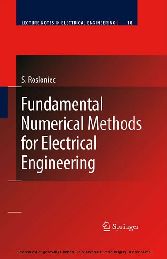Suchen und Finden
Service
Fundamental Numerical Methods for Electrical Engineering
Stanislaw Rosloniec
Verlag Springer-Verlag, 2008
ISBN 9783540795193 , 284 Seiten
Format PDF, OL
Kopierschutz Wasserzeichen
Geräte
Contents
5
About the Author
9
Introduction
11
Methods for Numerical Solution of Linear Equations
14
1.1 Direct Methods
18
1.1.1 The Gauss Elimination Method
18
1.1.2 The Gauss–Jordan Elimination Method
22
1.1.3 The LU Matrix Decomposition Method
24
1.1.4 The Method of Inverse Matrix
27
1.2 Indirect or Iterative Methods
30
1.2.1 The Direct Iteration Method
30
1.2.2 Jacobi and Gauss–Seidel Methods
31
1.3 Examples of Applications in Electrical Engineering
36
References
40
Methods for Numerical Solving the Single Nonlinear Equations
42
2.1 Determination of the Complex Roots of Polynomial Equations by Using the Lin’s and Bairstow’s Methods
43
2.1.1 Lin’s Method
43
2.1.2 Bairstow’s Method
45
2.1.3 Laguerre Method
48
2.2 Iterative Methods Used for Solving Transcendental Equations
49
2.2.1 Bisection Method of Bolzano
50
2.2.2 The Secant Method
51
2.2.3 Method of Tangents (Newton–Raphson)
53
2.3 Optimization Methods
55
2.4 Examples of Applications
57
References
60
Methods for Numerical Solution of Nonlinear Equations
62
3.1 The Method of Direct Iterations
62
3.2 The Iterative Parameter Perturbation Procedure
64
3.3 The Newton Iterative Method
65
3.4 The Equivalent Optimization Strategies
69
3.5 Examples of Applications in the Microwave Technique
71
References
81
Methods for the Interpolation and Approximation of One Variable Function
82
4.1 Fundamental Interpolation Methods
85
4.1.1 The Piecewise Linear Interpolation
85
4.1.2 The Lagrange Interpolating Polynomial
86
4.1.3 The Aitken Interpolation Method
89
4.1.4 The Newton–Gregory Interpolating Polynomial
90
4.1.5 Interpolation by Cubic Spline Functions
95
4.1.6 Interpolation by a Linear Combination of Chebyshev Polynomials of the First Kind
99
4.2 Fundamental Approximation Methods for One Variable Functions
102
4.2.1 The Equal Ripple (Chebyshev) Approximation
102
4.2.2 The Maximally Flat (Butterworth) Approximation
107
4.2.3 Approximation (Curve Fitting) by the Method of Least Squares
110
4.2.4 Approximation of Periodical Functions by Fourier Series
115
4.3 Examples of the Application of Chebyshev Polynomials in Synthesis of Radiation Patterns of the In- Phase Linear Array Antenna
124
References
133
Methods for Numerical Integration of One and Two Variable Functions
134
5.1 Integration of Definite Integrals by Expanding the Integrand Function in Finite Series of Analytically Integrable Functions
136
5.2 Fundamental Methods for Numerical Integration of One Variable Functions
138
5.2.1 Rectangular and Trapezoidal Methods of Integration
138
5.2.2 The Romberg Integration Rule
143
5.2.3 The Simpson Method of Integration
145
5.2.4 The Newton–Cotes Method of Integration
149
5.2.5 The Cubic Spline Function Quadrature
151
5.2.6 The Gauss and Chebyshev Quadratures
153
5.3 Methods for Numerical Integration of Two Variable Functions
160
5.3.1 The Method of Small (Elementary) Cells
160
5.3.2 The Simpson Cubature Formula
161
5.4 An Example of Applications
164
References
167
Numerical Differentiation of One and Two Variable Functions
168
6.1 Approximating the Derivatives of One Variable Functions
170
6.2 Calculating the Derivatives of One Variable Function by Differentiation of the Corresponding Interpolating Polynomial
176
6.2.1 Differentiation of the Newton–Gregory Polynomial and Cubic Spline Functions
176
6.3 Formulas for Numerical Differentiation of Two Variable Functions
181
6.4 An Example of the Two-Dimensional Optimization Problem and its Solution by Using the Gradient Minimization Technique
185
References
190
Methods for Numerical Integration of Ordinary Differential Equations
192
7.1 The Initial Value Problem and Related Solution Methods
192
7.2 The One-Step Methods
193
7.2.1 The Euler Method and its Modified Version
193
7.2.2 The Heun Method
195
7.2.3 The Runge–Kutta Method (RK 4)
197
7.2.4 The Runge–Kutta–Fehlberg Method (RKF 45)
199
7.3 The Multi-step Predictor –Corrector Methods
202
7.3.1 The Adams–Bashforth–Moulthon Method
206
7.3.2 The Milne–Simpson Method
207
7.3.3 The Hamming Method
210
7.4 Examples of Using the RK 4 Method for Integration of Differential Equations Formulated for Some Electrical Rectifier Devices
212
7.4.1 The Unsymmetrical Voltage Doubler
212
7.4.2 The Full-Wave Rectifier Integrated with the Three-Element Low- Pass Filter
217
7.4.3 The Quadruple Symmetrical Voltage Multiplier
221
7.5 An Example of Solution of Riccati Equation Formulated for a Nonhomogenous Transmission Line Segment
228
7.6 An Example of Application of the Finite Difference Method for Solving the Linear Boundary Value Problem
232
References
234
The Finite Difference Method Adopted for Solving Laplace Boundary Value Problems
236
8.1 The Interior and External Laplace Boundary Value Problems
239
8.2 The Algorithm for Numerical Solving of Two-Dimensional Laplace Boundary Problems by Using the Finite Difference Method
241
8.2.1 The Liebmann Computational Procedure
244
8.2.2 The Successive Over-Relaxation Method (SOR)
251
8.3 Difference Formulas for Numerical Calculation of a Normal Component of an Electric Field Vector at Good Conducting Planes
255
8.4 Examples of Computation of the Characteristic Impedance and Attenuation Coefficient for Some TEM Transmission Lines
258
8.4.1 The Shielded Triplate Stripline
259
8.4.2 The Square Coaxial Line
262
8.4.3 The Triplate Stripline
264
8.4.4 The Shielded Inverted Microstrip Line
266
8.4.5 The Shielded Slab Line
271
8.4.6 Shielded Edge Coupled Triplate Striplines
276
References
281
A Equation of a Plane in Three-Dimensional Space
282
B The Inverse of the Given Nonsingular Square Matrix
284
C The Fast Elimination Method
286
D The Doolittle Formulas Making Possible Presentation of a Nonsingular Square Matrix in the form of the Product of Two Triangular Matrices
288
E Difference Formula for Calculation of the Electric Potential at Points Lying on the Border Between two Looseless Dielectric Media Without Electrical Charges
290
F Complete Elliptic Integrals of the First Kind
292
Subject Index
294
Service
Shop



